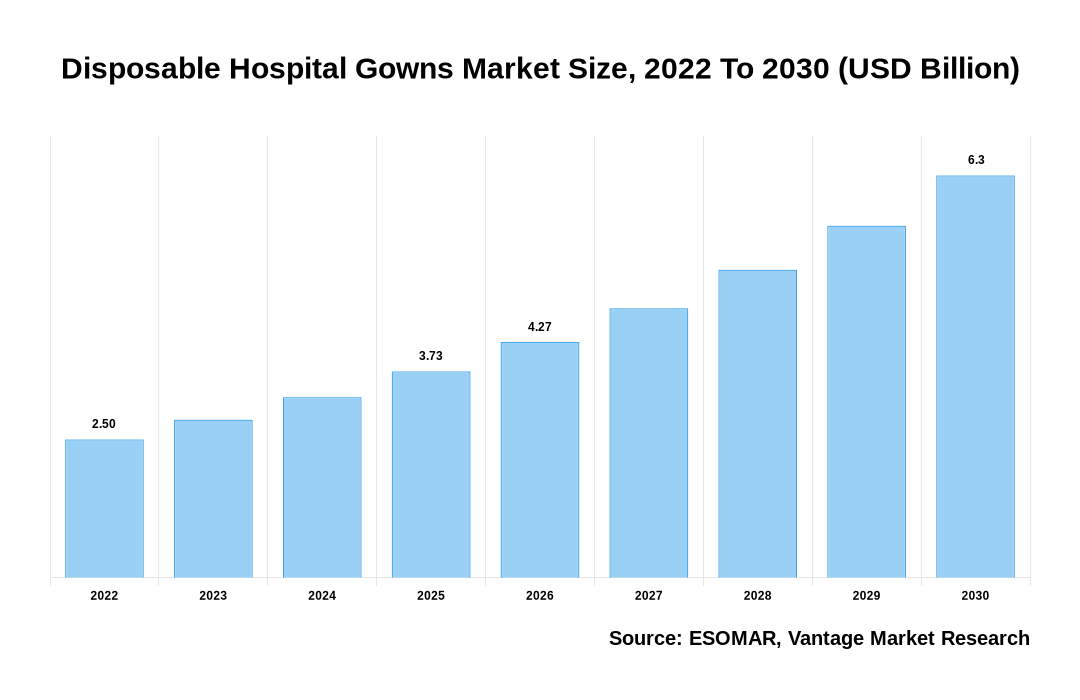Global Disposable Hospital Gowns Market
As stated in our extensive report, the Global Disposable Hospital Gowns Market accounted for USD 2.5 Billion in 2022 and is projected to reach a value of USD 6.3 Billion by 2030.
The global Disposable Hospital Gowns market is experiencing considerable growth, driven by several factors. Firstly, the increasing prevalence of healthcare-associated infections fuels the demand for Disposable Hospital Gowns. These gowns help prevent the spread of infections, thereby ensuring patient safety. The demand for disposable gowns is also increasing as people become more aware of the value of healthcare cleanliness and the necessity of infection control measures. The COVID-19 pandemic has greatly accelerated market growth due to increased patient admissions to healthcare facilities. The demand for extra disposable medical gowns has grown tremendously to control the spread of the infection. Additionally, technological developments have produced inventive and long-lasting disposable gowns, improving their effectiveness and usefulness and propelling the market’s expansion. In addition, strict rules enforced by healthcare organizations and governments addressing healthcare workers’ safety and infection control measures are also fostering market expansion. Disposable gowns are encouraged by these laws to prevent cross-contamination and ensure the safety of patients.
Click To Get a Free Sample On the Research Study

Factors Influencing Global Disposable Hospital Gowns Market Growth
The growth of the global Disposable Hospital Gowns market can be attributable to the following:
- The Disposable Hospital Gowns market is influenced by the rising number of surgical procedures worldwide. As surgical procedures increase, the demand for disposable gowns also rises.
- The COVID-19 pandemic has significantly increased the demand for Disposable Hospital Gowns globally. The need to protect healthcare workers and patients from the transmission of the virus has led to a surge in the adoption of disposable gowns in both COVID-19-specific facilities and general healthcare settings.
- Hospital-acquired infections, or healthcare-associated infections, are a major concern for healthcare facilities. Disposable Hospital Gowns help reduce the risk of infection transmission between patients and healthcare workers. The increasing awareness and focus on infection control measures drive the demand for disposable gowns.
- Regulatory bodies in various countries have set strict standards and guidelines for healthcare facilities to ensure patient safety and infection control. Compliance with these regulations requires the use of disposable gowns, driving the market growth.
- The development of advanced fabric materials that are more comfortable, breathable, and offer high barrier protection against infections influences the demand for disposable gowns. Manufacturers are constantly innovating to provide gowns with improved properties, such as antimicrobial coatings or fluid-resistant materials.
- The advancements in manufacturing technologies and automation have increased production capacity and improved quality of disposable gowns. This has led to a more cost-effective and streamlined supply chain, positively impacting market growth.
- Expanding healthcare infrastructure, particularly in emerging markets, drives the demand for Disposable Hospital Gowns. The construction and opening of new hospitals and clinics create opportunities for gown manufacturers to cater to the increasing demand.
- While the use of disposable gowns is essential for infection control, there is a growing emphasis on sustainable healthcare practices. This has led to the development and adoption of eco-friendly disposable gowns made from recyclable or biodegradable materials. The demand for sustainable options influences the market dynamics.
North America Region to Take Over the Market
The largest region in the Disposable Hospital Gowns market is North America. North America has a well-developed healthcare infrastructure and is known for its advanced medical facilities. The region also has a high demand for infection control products due to the presence of various infectious diseases and a high number of surgeries and hospital admissions. The Disposable Hospital Gowns market in North America is primarily driven by the United States, which has the largest healthcare expenditure in the world. The country spends a significant amount on infection prevention and control measures, including the use of Disposable Hospital Gowns. The increasing number of surgeries, rising awareness about healthcare-associated infections, and stringent regulations regarding healthcare safety and infection control are further boosting the demand for Disposable Hospital Gowns in the country.
Canada is also a significant contributor to the North America Disposable Hospital Gowns market. The country has a well-established healthcare system and a high demand for infection control products. The increasing prevalence of infectious diseases and the growing geriatric population are driving the demand for Disposable Hospital Gowns in Canada. Overall, North America dominates the global market for Disposable Hospital Gowns due to its advanced healthcare infrastructure, high healthcare expenditure, and stringent regulations regarding infection control. The region is expected to continue its dominance in the coming years, driven by factors such as the ongoing COVID-19 pandemic, the increasing number of surgeries, and growing awareness about infection prevention and control measures.
Conclusion
The overall sales of Disposable Hospital Gowns originally grew as a result of the outbreak’s high demand, but as cases began to fall and vaccination rates rose, this demand subsided. The Disposable Hospital Gowns market, however, may continue to experience consistent sales in the upcoming years due to the risk of additional outbreaks and the requirement for infection control measures.
The well-known players of the Global Disposable Hospital Gowns Market include Cardinal Health (U.S.), 3M (U.S.), Angelica Corp. (U.S.), Standard Textile Co. Inc. (U.S.), Medline Industries Inc. (U.S.), Petoskey Plastics Inc. (U.S.) and others.
![[Market Research Reports] – Research Google News Blog | VMR.Biz](https://www.vmr.biz/wp-content/uploads/2022/12/logo-removebg-preview.png)











